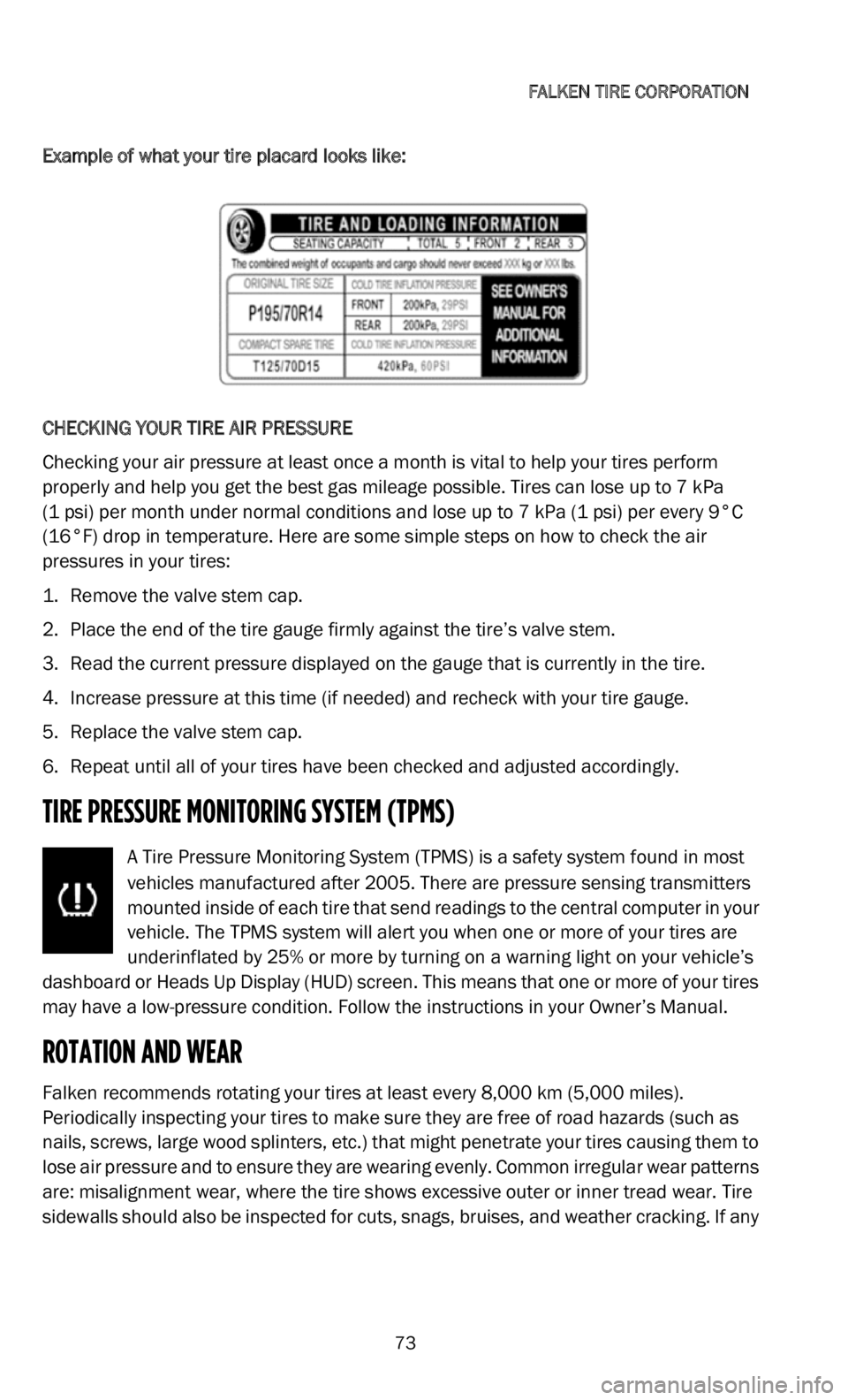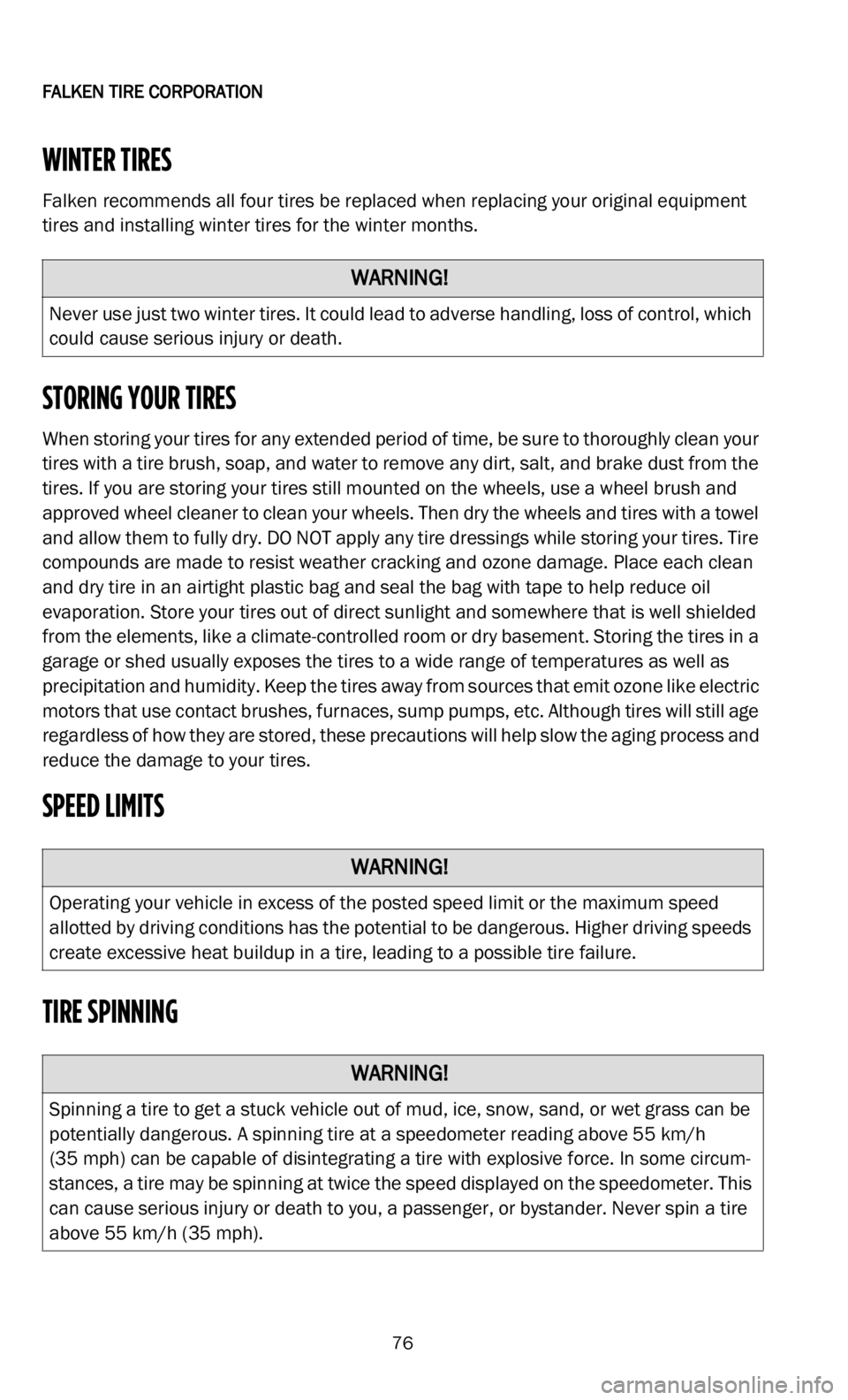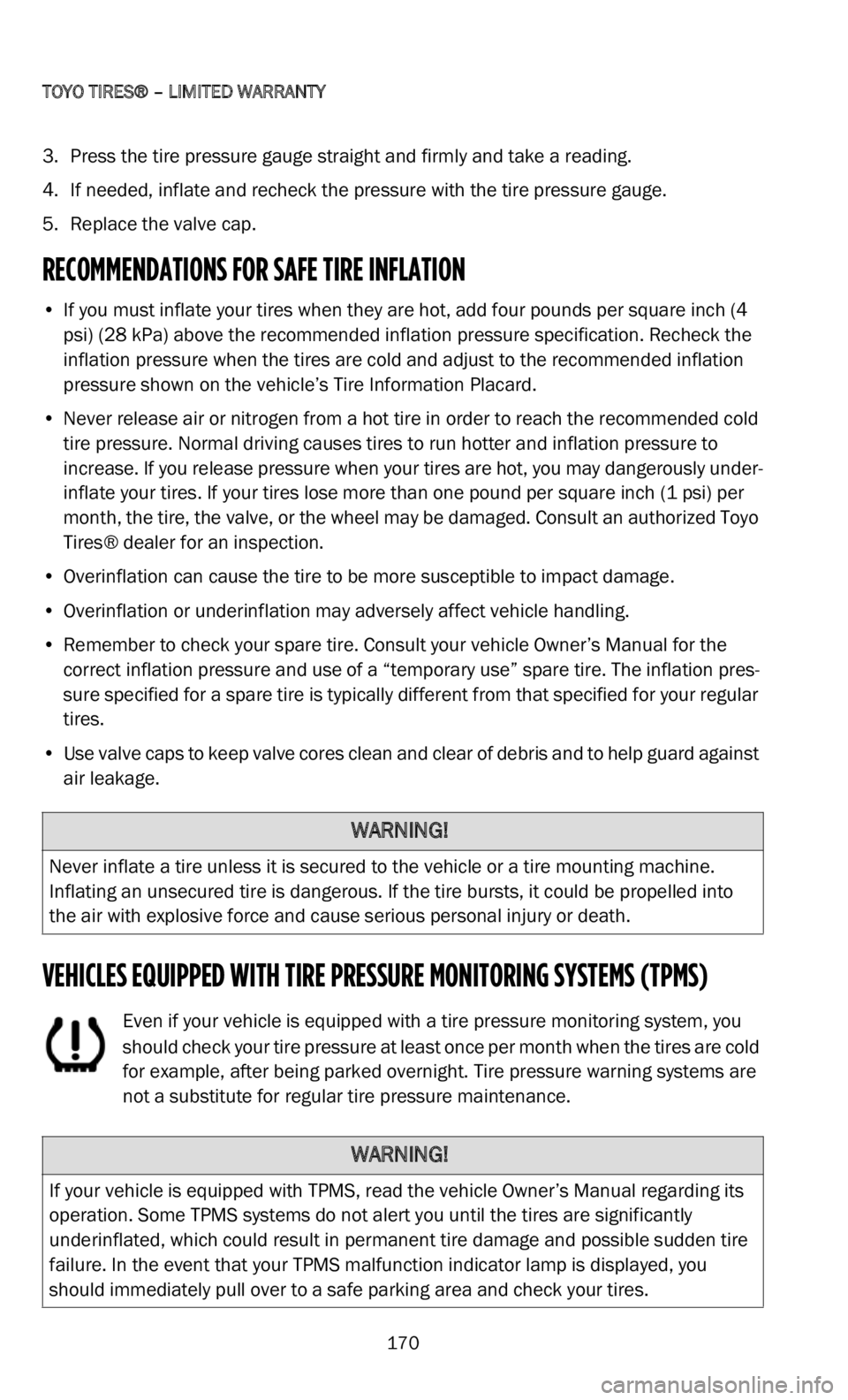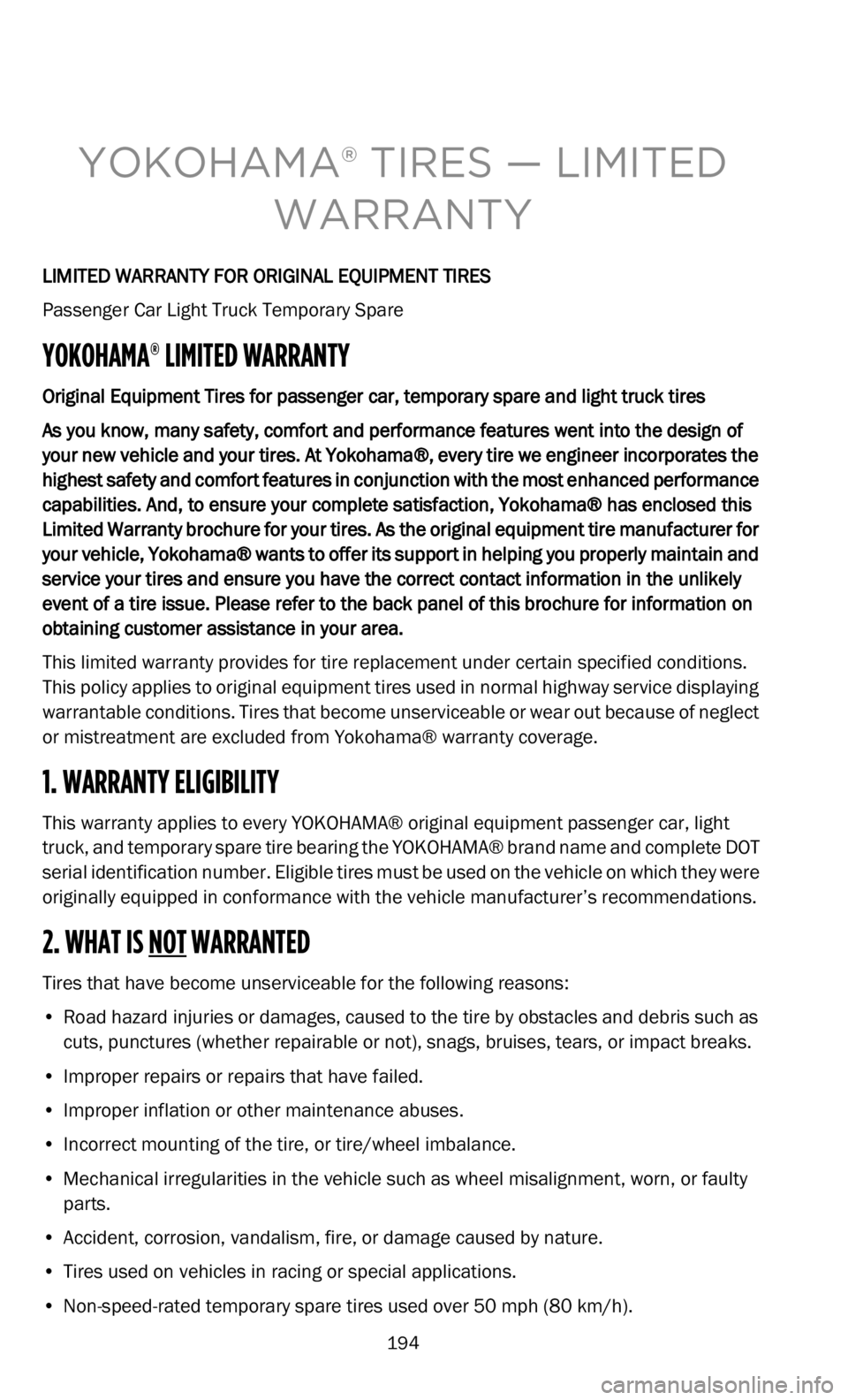display DODGE DURANGO 2022 Vehicle Warranty
[x] Cancel search | Manufacturer: DODGE, Model Year: 2022, Model line: DURANGO, Model: DODGE DURANGO 2022Pages: 200, PDF Size: 6.72 MB
Page 74 of 200

FALKEN TIRE CORPORATION
73
Example of what your tire placard looks like:
CHECKING YOUR TIRE AIR PRESSURE
Checking your air pressure at least once a month is vital to help your tires perform
p r
operly and help you get the best gas mileage possible. Tires can lose up to 7 kPa
(1 psi) per month under normal conditions and lose up to 7 kPa (1 psi) per every 9°C
( 1
6°F) drop in temperature. Here are some simple steps on how to check the air
pressures in your tires:
1. R emove the valve stem cap.
2
. P lace the end of the tire gauge firmly against the tire’s valve stem.
3
. R ead the current pressure displayed on the gauge that is currently in the tire.
4
. I ncrease pressure at this time (if needed) and recheck with your tire gauge.
5
. R eplace the valve stem cap.
6
. R epeat until all of your tires have been checked and adjusted accordingly.
TIRE PRESSURE MONITORING SYSTEM (TPMS)
A Tire Pressure Monitoring System (TPMS) is a safety system found in most
vehicles manufactured after 2005. There are pressure sensing transmitters
mo
unted inside of each tire that send readings to the central computer in your
vehicle. The TPMS system will alert you when one or more of your tires are
underinflated by 25% or more by turning on a warning light on your vehicle’s
dashboard or Heads Up Display (HUD) screen. This means that one or more of your tires
may have a low-pressure condition. Follow the instructions in your Owner’s Manual.
ROTATION AND WEAR
Falken recommends rotating your tires at least every 8,000 km (5,000 miles).
Pe
riodically inspecting your tires to make sure they are free of road hazards (such as
nails, screws, large wood splinters, etc.) that might penetrate your tires causing them to
lose air pressure and to ensure they are wearing evenly. Common irregular wear patterns
are: misalignment wear, where the tire shows excessive outer or inner tread wear. Tire
sidewalls should also be inspected for cuts, snags, bruises, and weather cracking. If any
Page 77 of 200

FALKEN TIRE CORPORATION 76
WINTER TIRES
Falken recommends all four tires be replaced when replacing your original equipment
tires and installing winter tires for the winter months.
STORING YOUR TIRES
When storing your tires for any extended period of time, be sure to thoroughly clean your
tires with a tire brush, soap, and water to remove any dirt, salt, and brake dust from the
tires. If you are storing your tires still mounted on the wheels, use a wheel brush and
approved wheel cleaner to clean your wheels. Then dry the wheels and tires with a towel
and allow them to fully dry. DO NOT apply any tire dressings while storing your tires. Tire
compounds are made to resist weather cracking and ozone damage. Place each clean
and dry tire in an airtight plastic bag and seal the bag with tape to help reduce oil
evaporation. Store your tires out of direct sunlight and somewhere that is well shielded
from the elements, like a climate-controlled room or dry basement. Storing the tires in a
garage or shed usually exposes the tires to a wide range of temperatures as well as
precipitation and humidity. Keep the tires away from sources that emit ozone like electric
motors that use contact brushes, furnaces, sump pumps, etc. Although tires will still age
regardless of how they are stored, these precautions will help slow the aging process and
reduce the damage to your tires.
SPEED LIMITS
TIRE SPINNING
WARNING!
Never use just two winter tires. It could lead to adverse handling, loss of control, which
could cause serious injury or death.
WARNING!
Operating your vehicle in excess of the posted speed limit or the maximum speed
allotted by driving conditions has the potential to be dangerous. Higher driving speeds
create excessive heat buildup in a tire, leading to a possible tire failure.
WARNING!
Spinning a tire to get a stuck vehicle out of mud, ice, snow, sand, or wet grass can be
potentially dangerous. A spinning tire at a speedometer reading above 55 km/h
( 3
5 mph) can be capable of disintegrating a tire with explosive force. In some circum -
stances, a tire may be spinning at twice the speed displayed on the speedometer. This
c a
n cause serious injury or death to you, a passenger, or bystander. Never spin a tire
above 55 km/h (35 mph).
Page 171 of 200

TOYO TIRES® – LIMITED WARRANTY
170
3. Press the tire pressure gauge straight and firmly and take a reading.
4. If needed, inflate and recheck the pressure with the tire pressure gauge.
5
. R eplace the valve cap.
RECOMMENDATIONS FOR SAFE TIRE INFLATION
• If you must inflate your tires when they are hot, add four pounds per square inch (4
psi) (28 kPa) above the recommended inflation pressure specification. Recheck the
inflation pressure when the tires are cold and adjust to the recommended inflation
pressure shown on the vehicle’s Tire Information Placard.
• N ever release air or nitrogen from a hot tire in order to reach the recommended cold
t
ire pressure. Normal driving causes tires to run hotter and inflation pressure to
increase. If you release pressure when your tires are hot, you may dangerously under -
inflate your tires. If your tires lose more than one pound per square inch (1 psi) per
m o
nth, the tire, the valve, or the wheel may be damaged. Consult an authorized Toyo
Tires® dealer for an inspection.
• O verinflation can cause the tire to be more susceptible to impact damage.
•
Overinflation or underinflation may adversely affect vehicle handling.
•
Remember to check your spare tire. Consult your vehicle Owner’s Manual for the
c
orrect inflation pressure and use of a “temporary use” spare tire. The inflation pres -
sure specified for a spare tire is typically different from that specified for your regular
t i
res.
• U se valve caps to keep valve cores clean and clear of debris and to help guard against
a
ir leakage.
VEHICLES EQUIPPED WITH TIRE PRESSURE MONITORING SYSTEMS (TPMS)
Even if your vehicle is equipped with a tire pressure monitoring system, you
should check your tire pressure at least once per month when the tires are cold
fo
r example, after being parked overnight. Tire pressure warning systems are
not a substitute for regular tire pressure maintenance.
WARNING!
Never inflate a tire unless it is secured to the vehicle or a tire mounting machine.
Inflating an unsecured tire is dangerous. If the tire bursts, it could be propelled into
the air with explosive force and cause serious personal injury or death.
WARNING!
If your vehicle is equipped with TPMS, read the vehicle Owner’s Manual regarding its
operation. Some TPMS systems do not alert you until the tires are significantly
underinflated, which could result in permanent tire damage and possible sudden tire
failure. In the event that your TPMS malfunction indicator lamp is displayed, you
should immediately pull over to a safe parking area and check your tires.
Page 195 of 200

194
YOKOHAMA® TIRES — LIMITED WARRANTY
LIMITED WARRANTY FOR ORIGINAL EQUIPMENT TIRES
Passenger Car Light Truck Temporary Spare
YOKOHAMA® LIMITED WARRANTY
Original Equipment Tires for passenger car, temporary spare and light truck tires
As you know, many safety, comfort and performance features went into the design of
you
r new vehicle and your tires. At Yokohama®, every tire we engineer incorporates the
highest safety and comfort features in conjunction with the most enhanced performance
capabilities. And, to ensure your complete satisfaction, Yokohama® has enclosed this
Limited Warranty brochure for your tires. As the original equipment tire manufacturer for
your vehicle, Yokohama® wants to offer its support in helping you properly maintain and
service your tires and ensure you have the correct contact information in the unlikely
event of a tire issue. Please refer to the back panel of this brochure for information on
obtaining customer assistance in your area.
This limited warranty provides for tire replacement under certain specified conditions.
Th i
s policy applies to original equipment tires used in normal highway service displaying
warrantable conditions. Tires that become unserviceable or wear out because of neglect
or mistreatment are excluded from Yokohama® warranty coverage.
1. WARRANTY ELIGIBILITY
This warranty applies to every YOKOHAMA® original equipment passenger car, light
truck, and temporary spare tire bearing the YOKOHAMA® brand name and complete DOT
serial identification number. Eligible tires must be used on the vehicle on which they were
originally equipped in conformance with the vehicle manufacturer’s recommendations.
2. WHAT IS NOT WARRANTED
Tires that have become unserviceable for the following reasons:
• Road hazard injuries or damages, caused to the tire by obstacles and debris such as
cu
ts, punctures (whether repairable or not), snags, bruises, tears, or impact breaks.
• Improper repairs or repairs that have failed.
• Im
proper inflation or other maintenance abuses.
• In
correct mounting of the tire, or tire/wheel imbalance.
• Me
chanical irregularities in the vehicle such as wheel misalignment, worn, or faulty
p a
rts.
• Accident, corrosion, vandalism, fire, or damage caused by nature. • Ti
res used on vehicles in racing or special applications.
• No
n-speed-rated temporary spare tires used over 50 m
ph (80 km/h).